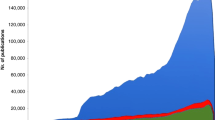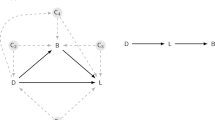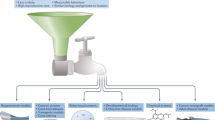Abstract
Although exposure to drugs or toxicants can affect children and adults very differently, many compounds lack specific safety information for children. Studies in juvenile animals can help researchers assess pediatric patients' potential response to certain chemicals. Juvenile studies are highly sensitive to animal age, sex and species and must be planned with care to prevent misinterpretation of experimental data. The author reviews considerations for the design of these studies, focusing on toxicological and pathological aspects.
This is a preview of subscription content, access via your institution
Access options
Subscribe to this journal
We are sorry, but there is no personal subscription option available for your country.
Buy this article
- Purchase on Springer Link
- Instant access to full article PDF
Prices may be subject to local taxes which are calculated during checkout
Similar content being viewed by others
References
Morford, L.L., Henck, J.W., Breslin, W.J. & DeSesso, J.J. Hazard identification and predictability of children's health risk from animal data. Environ. Health Perspect. 112, 266–271 (2004).
US Department of Health and Human Services, Food and Drug Administration, Center for Drug Evaluation and Research. Guidance for Industry: Nonclinical Safety Evaluation of Pediatric Drug Products. <[online]> (2006).
Beck, M.J. et al. in Developmental and Reproductive Toxicology (ed. Hood, R.D.) ch. 8 (CRC Taylor & Francis, Boca Raton, 2005).
Messplay, G.C. & Heisey, C. Encouraging pediatric studies. Contract Pharma 2007 (May), 18–20 (2007).
Nunn, T. The current availability of drugs for use in children – issues and solutions. Toxicol. Pathol. 35, 444 (2007).
Landrigan, P., Garg, A. & Droller, D.B.J. Assessing the effects of endocrine disruptors in the National Children's Study. Environ. Health Perspect. 111, 1678–1682 (2003).
Davis-Bruno, K.L. Regulatory perspective – current and upcoming guidelines on juvenile toxicology in the United States. Toxicol. Pathol. 35, 444 (2007).
Baldrick, P. Developing drugs for pediatric use: A role for juvenile animal studies? Regul. Tox. Pharmacol. 39, 381–389 (2004).
Kacew, S. in General and Applied Toxicology 2nd edn. (eds. Ballantyne, B., Marrs, T & Syverson, T.) 1215–1232 (Nature Publishing Group, London, 1999).
Zoetis, T. & Walls, I. Principles and Practices for Direct Dosing of Pre-weaning Mammals in Toxicity Testing and Research (ILSI, Washington, DC, 2003).
Tyl, R.W. & Marr, M.C. in Developmental and Reproductive Toxicology (ed. Hood, R.D.) ch. 7 (CRC Taylor & Francis, Boca Raton, 2005).
Barr, M. et al. Workshop to identify critical windows of exposure for children's health: cardiovascular and endocrine work group summary. Environ. Health Perspect. 108 (Suppl. 3), 569–571 (2000).
Pryor, J.L., Hughes, C., Foster, W., Hales, B.F. & Robaire, B. Critical windows of exposure for children's health: the reproductive system in animals and humans. Environ. Health Perspect. 108 (Suppl. 3), 491–503 (2000).
Rice, D. & Barone, S. Critical periods of vulnerability for the developing nervous system: evidence from humans and animal models. Environ. Health Perspect. 108 (Suppl. 3), 511–533 (2000).
Pinkerton, K.E. & Joad, J.P. The mammalian respiratory system and critical windows of exposure for children's health. Environ. Health Perspect. 108 (Suppl. 3), 457–462 (2000).
Sawaki, M. et al. Genital tract development in peripubertal female CD IGS rats. Comp. Med. 50, 284–287 (2000).
Birhaum, L.S. Pharmacokinetic basis of age-related changes in sensitivity to toxicants. Ann. Rev. Pharmacol. 31, 101–128 (1991).
Bruckner, J.V. Differences in sensitivity of children and adults to chemical toxicity: The NAS Panel Report. Regul. Tox. Pharmacol. 31, 280–285 (2000).
Scheuplein, R., Charnley, G. & Dourson, M. Differential sensitivity of children and adults to chemical toxicity I. Biological basis. Regul. Tox. Pharmacol. 35, 429–447 (2002).
Imaoka, S., Fujita, S. & Funae, Y. Age dependent expression of cytochrome P-450s in rat liver. Biochim. Biophys. Acta. 1097, 187–192 (1991).
Cresteil, T. Onset of xenobiotic metabolism in children: toxicological implications. Food Addit. Contamin. 15 (Suppl.), 45–51 (1998).
Hines, R.N. & McCarver, D.B. The ontogeny of human drug-metabolizing enzymes: phase I oxidative enzymes. J. Pharmacol. Exp. Ther. 300, 355–369 (2002).
Leeder, J.S. Issues in juvenile toxicity: the challenge of developmental drug biotransformation. Toxicol. Pathol. 35, 446 (2007).
Hoet J.J., Ozanne, S. & Reusens, B. Influences of pre- and postnatal nutritional exposures on vascular/endocrine systems in animals. Environ. Health Perspect. 108 (Suppl. 3), 563–568 (2000).
Yildiz, A., Hayirli, A., Okumus, Z., Kaynar, O. & Kisa, F. Physiological profile of juvenile rats: effects of cage size and cage density. Lab Anim. (NY) 36, 28–38 (2007).
Hew, K.W. & Keller, K.A. Postnatal anatomical and functional development of the heart: A species comparison. Birth Defects Res. B Dev. Reprod. Toxicol. 68, 309–320 (2003).
Walthall, K., Cappon, G.D., Hurtt, M.E. & Zoetis, T. Postnatal development of the gastrointestinal system: a species comparison. Birth Defects Res. B Dev. Reprod. Toxicol. 74, 132–156 (2005).
Zoetis, T., Tassinari, M.S., Bagi, C., Walthall, K. & Hurtt, M.E. Species comparison of postnatal bone growth and development. Birth Defects Res. B Dev. Reprod. Toxicol. 68, 111–120 (2003).
Zoetis, T. & Hurtt, M.E. Species comparison of lung development. Birth Defects Res. B Dev. Reprod. Toxicol. 68, 121–124 (2003).
Holsapple, M.P., West, L.J. & Landreth, K.S. Species comparison of anatomical and functional immune system development. Birth Defects Res. B Dev. Reprod. Toxicol. 68, 321–334 (2003).
Beckman, D.A. & Feuston, M. Landmarks in the development of the female reproductive system. Birth Defects Res. B Dev. Reprod. Toxicol. 68, 137–143 (2003).
Marty, M.S., Chapin, R.E., Parks, L.G. & Thorsrud, B.A. Development and maturation of the male reproductive system. Birth Defects Res. B Dev. Reprod. Toxicol. 68, 125–136 (2003).
Zoetis, T. & Hurtt, M.E. Species comparison of anatomical and functional renal development. Birth Defects Res. B Dev. Reprod. Toxicol. 68, 111–120 (2003).
Klapwijk, J. Experience of juvenile toxicity studies from a pathologist's perspective – developing drugs for children. Toxicol. Pathol. 35, 445 (2007).
Hall, W.C. et al. Histopathologic observations in weanling B6C3F1 mice and F344/N rats and their adult parental strains. Toxicol. Pathol. 20, 146–154 (1992).
Acknowledgements
I thank Kim Ehman of RTI International for her critical review of the manuscript and Ann Marie Hauck for preparation of the manuscript.
Author information
Authors and Affiliations
Corresponding author
Ethics declarations
Competing interests
The author declares no competing financial interests.
Rights and permissions
About this article
Cite this article
Seely, J. Toxicology and pathology considerations for the design of juvenile animal studies. Lab Anim 37, 206–209 (2008). https://doi.org/10.1038/laban0508-206
Received:
Accepted:
Issue Date:
DOI: https://doi.org/10.1038/laban0508-206



